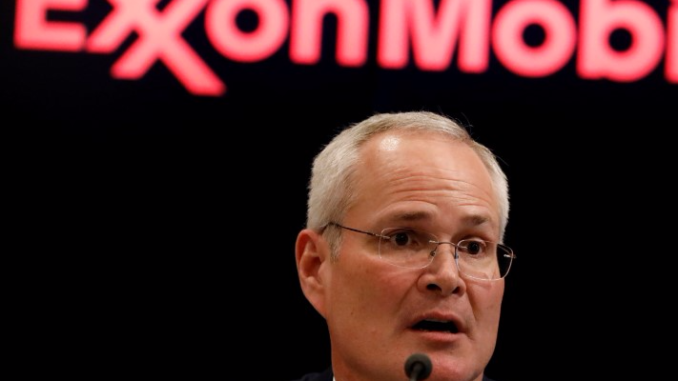
Good morning, and thank you for the opportunity to speak today.
Like all of us, I wear many hats.
In my professional life, I’m the CEO of ExxonMobil, one of the largest investor-owned companies in the world.
By training, I’m an engineer, which in many ways is how I still see myself – as someone who solves problems.
And in my personal life, I’m a father and grandfather – who cares about his family, their quality of life, and their futures.
Which means, I care very much about our environment and the health of our planet.
The Challenges We Face
My views on the climate challenge are informed by all of these perspectives, as is my commitment to finding solutions.
I’m fully aware that there are many who question ExxonMobil’s commitment because of what was said over 30 years ago or what they think Exxon knew back then.
Frankly, I’m more interested in what ExxonMobil knows today.
So, allow me to share this with you – here’s what ExxonMobil knows:
- Climate change is real,
- Human activity plays a major role,
- And, it is one of the major problems facing the world today – the need to address the very real threat of climate change.
But it’s not the only one.
Here’s another global problem, equally important – the need to continue producing affordable energy to maintain and raise living standards around the world.
Three billion people fall short of modern living standards, and far too many remain trapped in extreme poverty with no access to electricity or clean cooking fuels.
The global North-South divide will only be bridged when we commit to solving the world’s energy and emissions challenges simultaneously.
Oil and gas are at the center of both. Combusting them is a leading source of man-made greenhouse gas emissions. That’s the societal cost, and it’s real.
At the same time, the societal benefits of oil and gas are unmatched in human history. They’ve done more to grow economies, eradicate poverty and improve quality of life than anything else.
The Role of Energy Companies in the Energy Transition
If some of you are surprised by the clarity of ExxonMobil’s position on the climate challenge, even more noteworthy is the scale of our effort to address it.
If you were to list the biggest challenges facing humankind, addressing energy poverty and climate change are at the top.
And if you list the companies with a realistic chance to help improve access to energy and “bend the curve” on emissions, ExxonMobil would also be at the top.
To understand why, it’s important to grasp where the bulk of the world’s energy-related emissions come from. It’s not from the passenger vehicle sector that gets so much of the attention – cars and light trucks only account for 10% of energy-related CO2 emissions.
More than 80% come from commercial transportation, heavy industry, and power generation.
Wind and solar have great utility as a source of low-carbon electricity, but they just can’t get the job done in these hard-to-decarbonize sectors.
We need to open the aperture to a much broader set of solutions.
While renewable energy is essential to help the world achieve net zero, it is not sufficient – wind and solar alone can’t solve emissions in the industrial sectors that are at the heart of a modern society.
The technologies ExxonMobil is pursuing can.
Consider carbon capture and storage, where we capture emissions at the source, transport them by pipeline and permanently store them deep underground.
Just in the last year:
- We’ve signed carbon capture and storage agreements with a steel company, a fertilizer company, and an industrial-gas company.These three projects alone, will reduce CO2 emissions by the same amount as replacing 2 million cars with EVs. This is roughly the total number of electric vehicles on U.S. roads today.
- We’ve also secured exclusive rights to CO2 storage in Indonesia and Malaysia.With the right policy, we can create regional solutions for many of the industrial economies in Asia that don’t have large geologic formations suitable for storage.
- We’ve announced the world’s largest, low-carbon hydrogen plant, capable of producing 1 billion cubic feet per day.This single plant could produce nearly 10% of the Biden administration’s 2030 low-carbon hydrogen goal.
- We’re pursuing a dozen low-emission biofuels projects to meet what could be a 400% increase in demand by 2050.
- And, as we announced on Monday, we’re making a major investment in lithium production, which is essential to the world’s effort to electrify as much of the economy as possible.
All of this – and more – is supported by our investment of approximately 17 billion dollars over six years …and our almost $5 billion dollar acquisition of a company with the largest pipeline system in the U.S. for transporting and storing CO2.
When it comes to developing additional solutions, beyond wind, solar and EVs, nobody is investing more.
On an annualized basis, our spend is more than one third of the budget of the U.S. Environmental Protection Agency.
Think about that: One company, investing a third as much as the U.S. agency responsible for environmental protection.
World-scale problems like climate change, need world-scale companies to help solve them – like ExxonMobil.
Time to Get Serious
Despite progress toward net zero, serious obstacles remain. Many of the ideas being put forward to accelerate the energy transition are not based in economic, technological, or political reality.
To get serious about net zero, the world needs to get real.
We cannot replace overnight an energy system that took 150 years to build. The size and complexity are simply too vast.
Those who would tear down the existing energy system have the wrong problem statement. The problem is not oil and gas. It’s emissions.
Never before have we stopped using an energy source because of the byproduct it produces.
We successfully dealt with smog and acid rain by addressing harmful emissions, not by banning cars or shutting down power plants.
The solutions to climate change have been too focused on reducing supply.
That’s a recipe, for human hardship and a poorer world.
Leaving oil in the ground does nothing to stop the demand for it. It simply raises the price and makes it harder to alleviate poverty around the world.
The global North grew vastly wealthier because of economic growth powered by oil and gas.
The story is very different in the global South.
In non-OECD countries, income per person is still only 11,000 dollars a year.
No country has ever joined the developed world without access to oil and gas. The countries of the global South have every right to lift their people out of energy poverty and into the global middle class.
What Serious Looks Like
At the moment, net zero by 2050 remains an aspiration.
The Intergovernmental Panel on Climate Change and the International Energy Agency have both made clear that the world is not on the path to meet the goals of the Paris Agreement.
Pledges are not enough. The world needs a plan.
To get serious, three things are needed: supportive public policy, significant technology advancements, and a smooth transition from government subsidies to market-based mechanisms.
The governments of Asia-Pacific, and elsewhere, need to embrace constructive policy to encourage the shift to a lower-emissions future.
As a business leader who spends his time solving challenging large-scale problems, I’d like to suggest, some guiding principles:
- Don’t pick winners and losers.
- Don’t focus on an answer that fails to solve all aspects of the problem.
- For really complex issues like climate change… keep all viable solutions in play – even if they don’t align with your beliefs or ideology.
And, most importantly, leverage the power of competitive markets.
Market incentives for carbon reduction like a price on carbon, or policy incentives such as the U.S. Inflation Reduction Act, will drive innovation and engage all relevant players – leading to better solutions, faster.
We should allow technologies and companies to compete – and let the best solutions win.
For example, the IRA made the playing field for carbon capture more level by raising the incentive for CO2 removal to 85 dollars a ton. I say “more level” because the subsidy for electric vehicles is still 450 dollars a ton – or five times as high.
Technology-agnostic subsidies can kick-start a range of low-emission solutions, but they must have an expiration date.
- No government can afford to subsidize the energy transition forever.
Beyond incentives, we need a concentrated effort on advancing technology.
Collaboration is key. In simple terms, governments fund research, universities and labs conduct it, and companies develop and deploy it.
And we need an all-of-the-above approach. It’s far too early in the process to rule out any technology.
The final element critical to long-term success is market-based mechanisms.
When carbon reduction is economic, it will be everywhere.
Right now, that’s not the case. Low-carbon energy from solar to biofuels remains dependent on government support. Ultimately, the world must shift to market-based incentives to drive emissions lower.
As a practical matter, the world will need government policy to make this happen.
Let me close with this.
Oil and gas companies reliably provide affordable products essential to modern life.
Making them into villains is easy. But it does nothing – absolutely nothing – to accomplish the goal of reducing emissions.
In fact, it puts the reliable supply of energy at risk…destabilizing global economies, degrading people’s standards of living, and, as we saw in Europe, actually raising emissions.
The better approach – the constructive approach – is to harness the industry’s capabilities for change.
Put us to work. We’ve got the tools – the skills, the size, and the intellectual and financial resources – to bend the curve on emissions.
That’s what ExxonMobil Knows.
Thank you very much.
Source: Corporate.exxonmobil.com
ENB Top News
ENB
Energy Dashboard
ENB Podcast
ENB Substack



